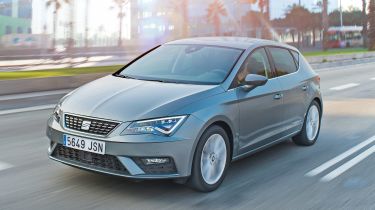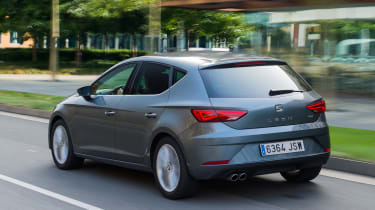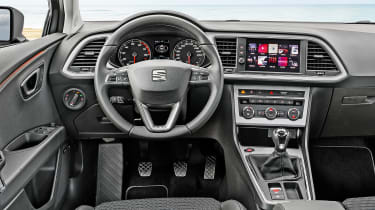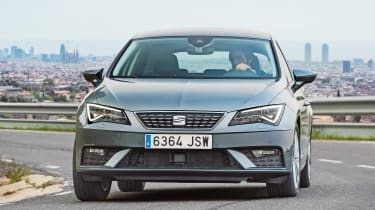New SEAT Leon 2016 facelift review
The SEAT Leon has received a facelift in a bid to compete with its hatchback rivals, but has it been improved?

Thanks to a light facelift, the Leon is better value than ever before - but the minor changes aren’t anything to shout about. It’s still a great alternative to the VW Golf, being a bit cheaper but not quite as comfortable or classy inside. This new 1.0-litre model is a great choice, offering a top mix of fuel economy and fun, matching the SEAT’s balanced character well, although it is quite a bit more expensive to buy than the 1.2-litre petrol.
The SEAT Leon has been one of our favourite hatchbacks since it launched in 2012. But with four years behind it, the family car was starting to fall behind newer rivals. That’s why SEAT has facelifted its most popular model, adding some extra kit and a subtle new look.
The Leon was always a handsome hatchback, sportier and more youthful than the closely-related VW Golf. That’s probably why the new model has been tweaked only slightly, with a new front bumper, an updated grille, fresh alloy wheel designs and a selection of new colours. There’s some new upholstery and lighting inside as well.
Extra equipment includes traffic sign recognition, wireless phone charging and traffic jam assist, which we first trialled on the new Ateca SUV. Cars from SE Dynamic Technology upwards (all but the two lowest specs) get an eight-inch touchscreen display, too. Our car wasn’t a UK spec car, so it got the larger screen - but the UK version makes do with a five-inch unit. That’s a real shame at this price point.
The infotainment system itself hasn’t changed much, but that’s no bad thing as it was already one of the most intuitive set-ups on sale – meaning the Leon is definitely still on par with most rivals when it comes to in-car tech.
Used - available now
There’s even a button that goes straight to your linked smartphone display, be it Apple CarPlay or Android Auto. Either way, it shows that SEAT knows how its customers are likely to use the system, as an extension of their phone.
Elsewhere, the plastics remain a little scratchy in places, but on the whole the Leon’s interior feels upmarket, and the dash is smart, if a little lacking in character. It’s a shame, actually, as outside, the Leon remains one of the most attractive hatchbacks.
As before, the Leon’s driving position is a little off for taller drivers, but if you’ve found a comfortable position in the previous model there won’t be an issue here. There’s plenty of room inside, with decent rear legroom and decent space up front. The centre console bin is a little small, and the cupholders are too shallow, though.
It’s still a comfortable drive, however, with the Leon striking a good balance between ride quality and driving involvement. The smooth Spanish roads of our test route didn’t give much away about the car’s on-road comfort, but the current car manages just fine in the UK - which hints that the new one will be just as good.
In the corners the SEAT is composed with lots of grip. The steering is well weighted, although there’s not that much feel. The lightweight 1.0-litre engine in our test car is new to the Leon range, having been used already in the VW Golf – and brings more agility. It’s not as good to drive as a Mazda 3, but the Leon has a better balance of ability.
The 113bhp engine feels a little underpowered if you’re not in the right gear, as the 200Nm of torque is only available from 2,000-3,500rpm. That means at low revs the tiny three-cylinder tends to bog down - but luckily it’s fun to rev, feels peppy in the mid-range and the six-speed manual gearbox is excellent. The shift action is smooth and the lever feels good in the hand, which all adds to the fun. Despite the impressive economy figures, there’s still enjoyment to be had behind the wheel.
The little engine will manage 64.2mpg, and emits just 102g/km – so it’s bound to be a hit with private and company car buyers alike. It looks like being the pick of the range, although it’s tough to be sure about real-world economy until we subject it to our UK road test. Still, tax will be nice and cheap, and the petrol unit is much more refined than the 1.6-litre TDI diesel you might otherwise go for.
In fact, thanks to some extra soundproofing, at idle the only way to tell the engine is even on is by feeling for vibrations through the gearstick. It really is that quiet. As you dial in more revs it starts to speak up, but it’s not an unpleasant noise. There’s not too much wind or road noise either, so the Leon is actually a pretty quiet car to drive at high speed.
It’s practical too, with the five-door still getting a 380-litre boot (matching the Golf) that opens up to 1,210 litres with the seats down. The boot is spacious rather than cavernous, and the seats don’t fold down completely flat, though.
With a starting price of around £17,000 the Leon looks like good value, if not quite as much of a bargain as the Vauxhall Astra, our reigning family hatch champion. That’s especially true when it comes to the 1.0-litre version, as the excellent three-cylinder unit in the Astra is available from just £16,615 compared to this car’s £18,995 price point.















